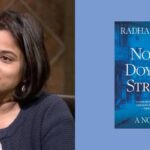How Pregnancy Forever Transforms the Body and the Mind
Lucy Jones on the Eternal Biological Bonds Between Mothers and Children
“This is where it transpires whether subject and object separate in the sense of the classical knowledge relation, or whether the subject enters the object to such an extent that the latter gives up its object character, indeed its presence and capacity for oppositeness as such.”
–Peter Sloterdijk, Bubbles
*Article continues after advertisement“Twenty-first-century biology is fundamentally different from twentieth-century biology. It is a biology of relationships rather than entities. The biology of anatomic individualism that had been the basis of genetics, anatomy, physiology, evolution, developmental biology, and immunology has been shown to be, at best, a weak first approximation of nature.”
–Scott Gilbert, “Rethinking Parts and Wholes”
*
Towards the end of pregnancy, when I felt sick or sore or tired or scared, I looked forward to having my body back: to being just me again, able to eat cheese and unlimited chocolate and drink five coffees a day. I thought, then, pregnancy was transient, a nine-month event, that my body was a box to grow a baby in. Once she was out, I’d return to my normal self.
Not so fast. During pregnancy, cells are exchanged between the mother and fetus via the placenta. When the baby is born, some of those cells remain intact in the mother’s body. For decades. Perhaps forever. The phenomenon is called microchimerism. The exchange creates what the leading geneticist Dr. Diana Bianchi calls a “permanent connection which contributes to the survival of both individuals.”
From the moment I was pregnant, I didn’t just feel different. I was different. I am different. On a cellular level. I would never be singular again.Cells have been found in subsequent siblings, too. If you have a younger brother or sister, they may have your cells within them, and, if they are older, their cells may be within you. Maternal cells also remain in the child. Dr. Bianchi and her team also found that a live birth was not required for a woman to “become a chimera,” meaning an organism containing cells from two or more individuals. Women who have miscarried will likely carry fetal cells within them.
How does this cell exchange happen? Humans have one of the most invasive placentas among mammals. The human placenta invades around one hundred uterine vessels and arteries and grows thirty-two miles of capillaries. If the capillaries in one placenta were laid out on the River Thames they would stretch across the entirety of London.
The tissues formed by the placenta to keep the baby alive would cover the Boor of a small room (120 to 150 square feet). The invasiveness of the placenta means more cellular exchange, which would suggest humans have more microchimerism than other species. When I was pregnant with my second child, after learning about this phenomenon, I was in awe of the placenta within me, and a little bit intimidated. It enabled the baby to eat and drink me.
In 2012, a research group in Seattle conducted a postmortem analysis of the brains of fifty-nine women who had carried babies. Almost two-thirds—63 percent—of the women had traces of DNA from fetal cells in their brains. Fetal cells have also been found in the liver, heart, lung, spleen, intestine, uterus, kidney, lymph nodes, salivary glands, heart, blood and skin. The baby’s impact on the maternal body extends far beyond the womb, endures long after delivery.
Why are these cells sticking around? What are they doing? How do they influence maternal biology and experience? There is a range of hypotheses.
Dr. Amy Boddy, a biologist at the University of California, Santa Barbara, takes an evolutionary approach to the subject. In the 2010s, while studying breast cancer and reading the literature, she discovered that scientists had found fetal cells in tumors in the breast.
“I thought: that’s weird,” she told me, over Zoom from her home in California. She dug in a little more and found that fetal cells were also remaining in other tissues in the maternal body, and specifically in “really interesting, reproductively important tissue” that might play a role in maternal health.
She started working in this area while pregnant with her second child. Unlike her easygoing first pregnancy, she found the second demanding and exhausting, which drove her interest in the conflict between fetal and maternal systems. Sometimes the baby wants more than the mother can give.
The lingering cells may just be a by-product of the lodger’s exit. But, in Boddy’s view, they must be there for a reason-possibly to do with the baby’s survival.
“Over one hundred million years of evolution, there is definitely time for manipulation of the maternal system,” Boddy said, likening it to an insurance policy for after the baby is born, especially in humans, where infants require intensive parental care.
One theory links it to breastfeeding. Fetal cells in breast tissue might help lactation, which is in the baby’s interest. They may also trigger the expression of important hormones in the maternal body, such as prolactin or oxytocin, which are respectively associated with feeding and bonding.
The impact of these microchimeric cells is a controversial and contested area of research. The presence of fetal cells in healed Cesarean section wounds suggests they could migrate to the site of damage to help in repair. But they’re also found at sites of disease, which could suggest they may have detrimental roles.
Pre-eclampsia—a common but serious condition in pregnancy which raises blood pressure—is associated with an over-proliferation of fetal cells. Fetal cells are also strongly implicated in the pathogenesis of autoimmune diseases, such as Graves’ and Hashimoto’s, as well as thyroid disease and inflammation that might contribute to postnatal psychiatric illness.
Still, we don’t know what the cells are doing at the sites of disease. They may have protective and regenerative roles: participating in tissue repair and regeneration, cell replacement or homeostatic maintenance. Women who have had children are more likely to survive lung cancer, which suggests that fetal cells-which establish in the lungs in particular-might suppress tumor development. They may have neutral roles, and be mere by-products.
The picture remains paradoxical. The interests of the mother and child are aligned in some areas but in conflict in others—both in pregnancy and once the baby is born.
Boddy suggested the research into fetal cells was in a similar place to microbiome science at the turn of the century. “People said, there’s bacteria and it’s important but we don’t know much about it. And now we know it’s very, very important for health. We’re at that stage of microchimerism where we know we have this diversity of cells within us but we don’t know how important that is yet.”
Bianchi’s landmark paper on microchimerism describes pregnancy as enacting a “long-term, low-grade chimeric state in the human female.” From the moment I was pregnant, I didn’t just feel different. I was different. I am different. On a cellular level. I would never be singular again.
*
Everything was ready for the baby’s arrival. We had bought soft new onesies and jumpsuits and friends had passed down clothes and slings. The baby would sleep in a family Moses basket and we had swaddles and a car seat. I learned that I would bleed for a while after giving birth, so I bought a box of sanitary napkins. That was it, I thought. Nothing I had read or heard suggested that what would come next would be a time I needed to prepare for.
I would end up needing around twenty boxes of specialist maternity pads for the blood loss following the birth.
In a meta-analysis of pregnancy lay literature and popular childbirth literature, academics Jennifer Benson and Allison Wolf found that the emotional and physical challenges of the postnatal period were “minimally acknowledged or simply ignored.” A major pregnancy book called Your Pregnancy dedicated just 0.08 percent of the book to maternal care after birth. Sections on maternal recovery focused on hair loss and weight loss.
I thought about how life started, for all of us. That experience we all have in common.Benson and Wolf conclude that the erasure of postpartum women in pregnancy and childbirth literature—what they call “the invisible postpartum mother”—is a form of misogynist oppression. They build on Sandra Banky’s theory of psychological oppression, in which the oppressed experience a “lack of a viable identity.” “Frequently we are unable to make sense of our own impulses or feelings… because we are forced to find our way in a world which presents itself to us in a masked and deceptive fashion.”
It is no surprise, then, that a 2018 study by researchers at the University of Louisville, Kentucky, found that women leaving hospital after giving birth did not know about the risk factors for maternal mortality and problems, including mental illness. Over 60 percent had no idea that pregnancy-related complications can occur for up to one year after birth.
*
In the final days of pregnancy I hauled myself out of the house, barreled down the road and into a local park. The boundaries between myself and the rest of life here were thinner, more porous. I felt open to the processes around me, as if the membrane of my consciousness was stretching, like the taut skin across my stomach. I lifted my hand to stroke the bark of a plane tree. I was starting to find more of a mirror, or a sense of kinship, in the natural world than I did in any of the books or leaflets I read, or the stories I heard, which failed to provide a compass for the existential upheaval I was experiencing. I was beginning to understand myself in a new way, as an ecological being.
Suddenly, I smelled flesh. I lifted my head. It smelled like meat, blood, burgers, salt. I looked around and saw a shape on the ground. My eyes focused and I walked towards it. It was the wings and remains of a bird. The feathers were striped in light and dark brown and its body had been removed. All that remained were the soft wings and strands of sinew, tissue and blood on its skeleton and cartilage. The smell was so strong I had to walk away. The bird would degrade and disintegrate, as my baby strengthened and fattened.
I imagined how she must feel in my womb, cramped and tight, warm and soft, bound by the elastic walls of abdominal muscles and fascia. A house within a house. She could be touching the blue ribbed scarf of the umbilical cord, waiting for the pattern of food she had become used to. I thought about how life started, for all of us. That experience we all have in common: we began in a body, in loud fluid, within a tight space, a dark, wet, rhythmic nest, in a being also becoming. Our first world.
I felt a great sense of responsibility to bring her safely onto the earth. Tears of tension fell. My patience waxed and waned. The world was beautiful. Colors were vivid. Birdsong was a symphony. Then, I would be fed up. I couldn’t sleep. I couldn’t talk. I was obsessed with the baby’s departure from my body, our first uncoupling. Aquatic to terrestrial, dark to life, occult to revelation, small hot cave to earthly consciousness. Memories of childhood teachings about Ruach from Genesis—the spirit that moves over the face of the waters-lapped over me in the early hours of the morning.
The magma was melting, the mantle would shift, and soon there would be an eruption, though I didn’t know exactly when, or what form it would take.
__________________________________

From Matrescence: On Pregnancy, Childbirth, and Motherhood by Lucy Jones. Copyright © 2024. Available from Pantheon Books, an imprint of Knopf Doubleday Publishing Group, a division of Penguin Random House, LLC.




















